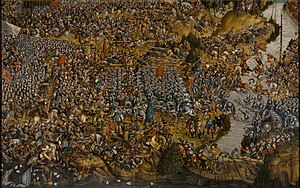Battle of Orsha
| Battle of Orsha | |||||||
|---|---|---|---|---|---|---|---|
| Part of the fourth Muscovite–Lithuanian War (1512–1522) | |||||||
 Painting attributed to Hans Krell |
|||||||
|
|||||||
| Belligerents | |||||||
| Grand Duchy of Lithuania, Kingdom of Poland | Grand Duchy of Moscow | ||||||
| Commanders and leaders | |||||||
| Konstanty Ostrogski | Ivan Chelyadnin (POW) | ||||||
| Strength | |||||||
|
12,000 300 cannons |
12,000 140 to 300 cannons |
||||||
| Casualties and losses | |||||||
| Unknown | 13,000-40.000 dead and wounded, at least 5,000 captured | ||||||
12,000
25,000
12,000
35,000-40,000
The Battle of Orsha was fought on 8 September 1514, between the allied forces of the Grand Duchy of Lithuania and the Kingdom of Poland, under the command of Hetman Konstanty Ostrogski; and the army of the Grand Duchy of Moscow under Konyushy Ivan Chelyadnin and Kniaz Mikhail Golitsin. The Battle of Orsha was part of a long series of Muscovite–Lithuanian Wars conducted by Muscovite rulers striving to gather all the former Kievan Rus' lands under their rule.
According to Rerum Moscoviticarum Commentarii by Sigismund von Herberstein, the primary source for information on the battle, the much smaller army of Poland–Lithuania (under 30,000 men) defeated a force of 80,000 Muscovite soldiers, capturing their camp and commander. These numbers and proportions have been disputed by modern historians.
At the end of 1512, the Grand Duchy of Moscow began a new war for the Grand Duchy of Lithuania's Ruthenian lands in present-day Lithuania, Belarus and Ukraine. Albrecht I, Grand Master of the Teutonic Knights, rebelled and refused to give a vassal pledge to Sigismund I the Old of Poland-Lithuania, as required by the Second Peace of Thorn (1466). Albrecht I was supported by Maximilian I, Holy Roman Emperor.
...
Wikipedia
